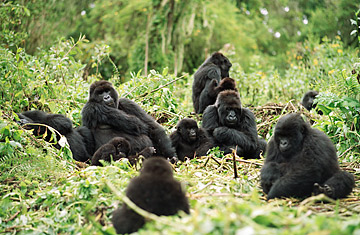
Mountain gorillas resting in Volcanoes National Park, Rwanda
(2 of 2)
This should work. Generally, when a gorilla family gets up in the morning, it doesn't move much, no more than 600 m to 1,000 meters from where it spent the night. So the guides chart where the clans settle down to sleep and can thus guarantee visitors sightings the next morning. We're going to see the Hirwa clan; hirwa means luck.
The jungle gets denser as we walk, and our knapsacks catch on the bamboo, which is what gorillas like to eat best. Just when we're wondering how long it's going to take to get to the gorillas, two little ones appear, romping around. Their mother sits nearby, breast-feeding a baby gorilla.
There are cracking — and grunting — sounds all around us: that's what gorillas sound like when they're eating breakfast, as they break off and bite into bits of bamboo and wild celery. They prefer to do this lying on their backs, looking at the sky.
Now the silverback, Muninya, puts in an appearance — a pack of muscle with a well-groomed blue-black pelt. He's the only male in the whole park who's ever managed to get two females away from other clans on the same day, to add to his harem, Anaklet says.
The animals appear undisturbed by our presence, in fact keeping distance from them is impossible: we try, but the gorillas couldn't care less. A small ape of about 3 years of age comes scampering through our group and is fetched by his laid-back mother, who comes to scoop him up.
When the silverback appears to get a bit irritated, our guide makes a weird kind of gargling noise — and this produces a calming effect.
It's now time to head back: visitors are allowed only about an hour a day with the gorillas so the animals don't get disturbed. But before we go, the highlight: Muninya, the silverback, organizes the clan, big and small apes alike, and marches them right through our group as if leading a holiday parade. We're so astonished, we forget all about taking pictures. And then they march off.
That afternoon, we go to visit the Village of the Ex-Poachers. "All the men here are now wardens at the National Park," says Manzi Kayihura, local head of Thousand Hills Expeditions. "And we have tourism to thank for that."
When the massacres came to an end in Rwanda, the policy of reconciliation that followed made it possible for the country to quickly welcome tourists too. Tourism has since become the country's biggest source of revenue — bigger even than tea and coffee-bean farming. The ex-poachers nod in agreement when Kayihura the tour organizer says, "Tourism is the best way to heal our wounds."
On the last day, Jimmy, the driver, tells his story. A refugee in Congo, he became a rebel fighter, hence the scar on his arm. But now he has a good job. He believes in Rwanda. Tourism will help him.
Also from Worldcrunch:
Illegal Parking in Crime-Plagued Naples? There's a Google Map for That
— La Stampa
Why the Survival of the Great Hamsters of Alsace Is Important
— Le Monde
Amsterdam: Time to Squash the Squatters
— Le Monde
